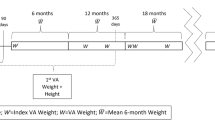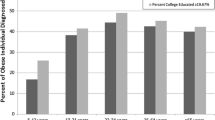Abstract
BACKGROUND: Few national data exist about the prevalence of obesity and the resulting health burden among veterans.
METHODS: We analyzed data from the 2003 Behavioral Risk Factor Surveillance System (n=242,362) to compare rates of obesity among veterans who do and do not utilize the VA, compared with nonveterans. We used bivariate analyses to describe the association of obesity with lifestyle factors, disability, and comorbid disease, and multivariate analysis to assess the independent association of obesity with VA care.
RESULTS: Veterans who use the VA for health care have the highest rates of obesity compared with veterans who do not use the VA and nonveterans (27.7% vs 23.9% vs 22.8%,P<.001). Only 27.8% of veterans who receive health care at the VA are of normal weight (vs 42.6% of the general population,P<.001), 44.5% are overweight, 19.9% have class I obesity, 6% have class II obesity, and 1.8% are morbidly obese (an estimated 82,950 individuals). Obese veterans who utilize the VA for services have higher rates of hypertension (65.8%) and diabetes (31.3%), are less likely to follow diet and exercise guidelines, and more likely to report poor health and disability than their normal-weight counterparts.
CONCLUSIONS: Veterans who receive care at the VA have higher rates of overweight and obesity than the general population. At present, less than half of VA medical centers have weight management programs. As the largest integrated U.S. health system, the VA has a unique opportunity to respond to the epidemic of obesity.
Similar content being viewed by others
References
Flegal KM, Carroll MD, Ogden CL, Johnson CL. Prevalence and trends in obesity among US adults, 1999–2000. JAMA. 2002;288:1723–7.
Must A, Spadano J, Coakley EH, Field AE, Colditz G, Dietz WH. The disease burden associated with overweight and obesity. JAMA. 1999;282:1523–9.
Peeters A, Barendregt JJ, Willekens F, Mackenbach JP, Al Mamun A, Bonneux L. Obesity in adulthood and its consequences for life expectancy: a life-table analysis. Ann Intern Med. 2003;138:24–32.
Raebel MA, Malone DC, Conner DA, Xu S, Porter JA, Lanty FA. Health services use and health care costs of obese and nonobese individuals. Arch Intern Med. 2004;164:2135–40.
Arterburn DE, McDonell MB, Hedrick SC, Diehr P, Fihn SD. Association of body weight with condition-specific quality of life in male veterans. Am J Med. 2004;117:738–46.
Flegal KM, Graubard BI, Williamson DF, Gail MH. Excess deaths associated with underweight, overweight, and obesity. JAMA. 2005;293:1861–7.
Das SR, Kinsinger LS, Yancy J, et al. Obesity prevalence among veterans at Veterans Affairs medical facilities. Am J Prev Med. 2005;28:291–4.
Nowicki EM, Billington CJ, Levine AS, Hoover H, Must A, Naumova E. Overweight, obesity, and associated disease burden in the Veterans Affairs ambulatory care population. Mil Med. 2003;168:252–6.
Wang A, Kinsinger LS, Kahwati LC, et al. Obesity and weight control practices in 2000 among veterans using VA facilities. Obes Res. 2005;13:1405–11.
CDC. 2003. Behavioral Risk Factor Surveillance System, Summary Data Quality Report. Available at: http://www.cdc.gov/brfss/technical_infodata/pdf/2003SummaryDataQualityReport.pdf. Accessed August 16, 2005.
Executive summary of the clinical guidelines on the identification, evaluation, and treatment of overweight and obesity in adults. Arch Intern Med. 1998;158:1855–67.
Nelson DE, Holtzman D, Bolen J, Stanwyck CA, Mack KA. Reliability and validity of measures from the Behavioral Risk Factor Surveillance System (BRFSS). Soz Praventivmed. 2001;46(suppl 1):S3-S42.
Self-reported frequent mental distress among adults—United States, 1993–1996. MMWR. 1998;47:325–31.
Stein AD, Courval JM, Lederman RI, Shea S. Reproducibility of responses to telephone interviews: demographic predictors of discordance in risk factor status. Am J Epidemiol. 1995;141:1097–105.
Ainsworth BE, Haskell WL, Whitt MC, et al. Compendium of physical activities: an update of activity codes and MET intensities. Med Sci Sports Exerc. 2000;32(9 suppl):S498-S504.
Physical activity trends—United States, 1990–1998. MMWR. 2001;50:166–9.
Pi-Sunyer FX. Medical hazards of obesity. Ann Intern Med. 1993;119(7 Part 2):655–60.
Daviglus ML, Liu K, Yan LL, et al. Relation of body mass index in young adulthood and middle age to Medicare expenditures in older age. JAMA. 2004;292:2743–9.
Poston WS, Haddock CK, Peterson AL, et al. comparison of weight status among two cohorts of US Air Force recruits. Prev Med. 2005;40:602–9.
McTigue KM, Harris R, Hemphill B, et al. Screening and interventions for obesity in adults: summary of the evidence for the U.S. Preventive Services Task Force. Ann Intern Med. 2003;139:933–49.
Buffington CK, Marema RT. Ethnic differences in obesity and surgical weight loss between African-American and Caucasian females. Obes Surg. 2006;16:159–65.
Under Secretary for Health’s Information Letter: “The Managing Overweight and/or Obesity for Veterans Everywhere (MOVE!) Program,” IL 10-2004-014. Available at: http://www.move.med.va.gov/download/MoveInfoLetter.pdf. Accessed October 5, 2004.
Stern L, Iqbal N, Seshadri P, et al. The effects of low-carbohydrate versus conventional weight loss diets in severely obese adults: one-year follow-up of a randomized trial. Ann Intern Med. 2004;140:778–85.
Freedman DS, Khan LK, Serdula MK, Galuska DA, Dietz WH. Trends and correlates of class 3 obesity in the United States from 1990 through 2000. JAMA. 2002;288:1758–61.
Schneider BE, Mun EC. Surgical management of morbid obesity. Diabetes Care. 2005;28:475–80.
Livingston EH, Liu CY, Glantz G, Li Z. Characteristics of bariatric surgery in an integrated VA Health Care System: follow-up and outcomes. J Surg Res. 2003;109:138–43.
Gallagher SF, Banasiak M, Gonzalvo JP, et al. The impact of bariatric surgery on the Veterans Administration healthcare system: a cost analysis. Obes Surg. 2003;13:245–8.
Flum DR, Salem L, Broeckel Elrod JA, Dellinger EP, Cheadle A, Chan L. Early mortality among medicare beneficiaries undergoing bariatric surgical procedures. JAMA. 2005;294:1903–8.
Craig BM, Tseng DS. Cost-effectiveness of gastric bypass for severe obesity. Am J Med. 2002;113:491–8.
Sjostrom L, Lindroos A-K, Peltonen M, et al. Lifestyle, diabetes, and cardiovascular risk factors 10 years after bariatric surgery. N Engl J Med. 2004;351:2683–93.
VHA National Center for Health Promotion and Disease Prevention, VA Bariatric Surgery Resource Center. Available at: http://www.nchpdp.med.va.gov/BariatricSurgery.asp. Accessed December 10, 2005.
Rosenheck R, Frisman L, Chung AM. The proportion of veterans among homeless men. Am J Public Health. 1994;84:466–9.
Gamache G, Rosenheck R, Tessler R. Overrepresentation of women veterans among homeless women. Am J Public Health. 2003;93:1132–6.
Kazis LE, Miller DR, Clark J, et al. Health-related quality of life in patients served by the Department of Veterans Affairs: results from the Veterans Health Study. Arch Intern Med. 1998;158:626–32.
Onyike CU, Crum RM, Lee HB, Lyketsos CG, Eaton WW. Is obesity associated with major depression? Results from the third national health and nutrition examination survey. Am J Epidemiol. 2003;158:1139–47.
Carpenter KM, Hasin DS, Allison DB, Faith MS. Relationships between obesity and DSM-IV major depressive disorder, suicide ideation, and suicide attempts: results from a general population study. Am J Public Health. 2000;90:251–7.
Johnson ML, Pietz K, Battleman DS, Beyth RJ. Prevalence of comorbid hypertension and dyslipidemia and associated cardiovascular disease. Am J Manage Care. 2004;10:926–32.
Miller DR, Safford MM, Pogach LM. Who has diabetes? Best estimates of diabetes prevalence in the Department of Veterans Affairs based on computerized patient data. Diabetes Care. 2004;27(suppl 2):B10-B21.
Fihn SD, McDonell MB, Diehr P, et al. Effects of sustained audit/feedback on self-reported health status of primary care patients. Am J Med. 2004;116:241–8.
Galuska DA, Serdula M, Pamuk E, Siegel PZ, Byers T. Trends in overweight among US adults from 1987 to 1993: a multistate telephone survey. Am J Public Health. 1996;86:1729–35.
Calle EE, Thun MJ, Petrelli JM, Rodriguez C, Heath CW Jr. Body-mass index and mortality in a prospective cohort of U.S. adults. N Engl J Med. 1999;341:1097–105.
Stewart AW, Jackson RT, Ford MA, Beaglehole R. Underestimation of relative weight by use of self-reported height and weight. Am J Epidemiol. 1987;125:122–6.
Nieto-Garcia FJ, Bush TL, Keyl PM. Body mass definitions of obesity: sensitivity and specificity using self-reported weight and height. Epidemiology. 1990;1:146–52.
Author information
Authors and Affiliations
Corresponding author
Additional information
The views expressed in this article are those of the author and do not necessarily represent the views of the Department of Veterans Affairs.
This study received funding from the Epidemiologic Research and Information Center, VA Puget Sound Health Care System, Seattle, WA (ERIC XVA 61). This research was presented in part at the April 26–29, 2006 annual meeting of the Society for General Internal Medicine, Los Angeles, CA, at the May 16–19 CDC Diabetes and Obesity Conference 2006, Denver, CO, and at the June 25–27 Academy Health Annual Research Meeting, Seattle, WA.




